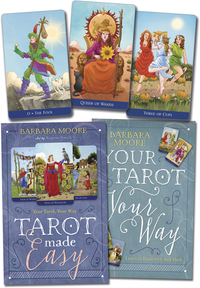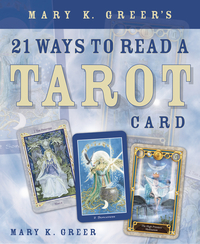Llewellyn Publications's Blog, page 42
November 8, 2017
The Marseille Tarot Revealed by Yoav Ben-Dov
Although this book is specifically written for use with a Marseille Tarot-style deck, I found a lot of useful information that can apply to any reading with any tarot deck.
Yoav includes a section on reading symbolic language in the cards. He includes categories that many of us have seen before, such as color and number, but he includes other categories that are less commonly discussed. I found the section of body parts particularly interesting.
Although I never had what I consider a formal method of interpreting body parts, I realized that I do casually think about body parts symbolically. For example, I usually notice if a character is wearing any sort of headpiece such as a crown or a hat, which to me denotes what is on someone’s mind. I notice the feet, whether they are bare or with shoes or boots, whether they are firmly on the ground, moving, or in water. Let’s take a look at Yoav says:
Body parts of tarot figures can be interpreted in several ways. One way is to interpret the body parts metaphorically according to their function and use. For example, a hand symbolizes what the querent is doing. An eye symbolizes what they can or want to see. The shoulders can represent the burden they are carrying. A belly is what they contain and keep inside. A woman figure with a round belly can express pregnancy with something, not necessarily a real child. The legs represent the stability of the querent’s position or their ability to move. Whatever is under them can be the basis on which they stand.
In the book he goes on to compare certain parts of the body to the minor suits (leg = pentacles, pelvis = wands, chest = cups, head = swords). You’ll have to get the book for his take on these connections, but even if you don’t, spend some time and think about the possibilities and maybe other potential connections.
This is a beautiful, full color book that will be useful to any tarot reader, whether they use the Marseille or not. Take a peek and see if it interests you: http://www.llewellyn.com/product.php?ean=9780738752280

October 30, 2017
Tips for Doing a Paranormal Investigation
Readers, please enjoy this guest blog post by Carol Matsumoto, author of the new THe Ghosts of Captain Grant’s Inn.
I own Captain Grant’s 1754, a haunted inn in Connecticut. We have a cemetery across the street and one dating to the mid 1600s behind the inn. There isn’t a month that goes by without ghost hunters calling and asking to do paranormal investigations. We have seen all types of groups: the experienced, the novices, and everything in between. Here are some thoughts I have on how to—or not to do—an investigation.
Do not bring a large group with you. While more is usually the merrier, you will have almost no chance of getting anything paranormal on your equipment. I suggest three to five people maximum. Be quiet and respectful to the spirits that you are trying to contact. They were alive at one time.
Do consider all tools that are available. Do not dismiss something, even if you believe it to be ineffective. Instead, consider all that is out there to consider, and don’t leave any idea at the door. You may be surprised by what you are able to find. I had one guest say that divining rods were “phony,” and he refused to even consider seeing them in action. Well, they have been working for centuries and are the oldest tool that we have.
Don’t anticipate seeing paranormal phenomena on a tour. Ghost tours are definitely fun and informative, but the chances of seeing an apparition or other phenomena are slim. Instead, go for the experience and enjoy yourself.
Don’t believe there is inactivity if your investigation fails to yield evidence. I had a man who left the Inn quite angrily, stating, “You have no spirits here. It’s all hype.” Well, we have only one spirit that likes to talk to men; his name is Liam and he is a gay man from the 1700s. He pinches men’s rears and likes to lay on top of them. Apparently he did not like this man and so did not appear.
Don’t charge for your investigations. You might think your investigation is doing the owners a service, but, if we’re honest, the investigation is for your satisfaction and knowledge. It is the last frontier and you want to be there. You could come across as naive and inexperienced.
This is truly a new frontier. We need more investigators to take a scientific approach to the world beyond life. There are many areas to explore, from angels and spirits to apparitions and poltergeists. We need your knowledge! Together we will find the truth.
Our thanks to Carol for her guest post! For more from Carol Matsumoto, read her article, “6 Myths About Ghosts.”
October 25, 2017
At Omega with Me…Barbara Moore
This summer, the Omega Institute offered a Masters of Tarot weekend workshop featuring me, Theresa Reed, Sasha Graham, Mary Greer, and Rachel Pollack. One of the signs of a good teacher is that they are always investigating and exploring. Even if you’ve had classes with them before or read their books, they always have something new to offer…or perhaps a new approach to an old favorite topic. It was a wonderful weekend for both us teachers and for the students.
I am probably most well-known for my Steampunk Tarot, Tarot Spreads, and Your Tarot Your Way. As teacher, I like to share some of whatever philosophy, neuroscience, sacred studies, and psychology ideas that are filling my head at the time. No matter what I talk about, I always bolster the class with plenty of hands on activities and practical application.
My workshop at Omega was ostensibly on Significators but the larger, underlying message was how to make sure your tarot practice reflects your beliefs.
You see, I taught about the traditional methods of selecting and using significators. We analyzed them in terms of their strengths and weaknesses. We explored ways to build on the strengths and eliminate the weaknesses. In the end, we were able to create some modern significator selection methods and techniques that were useful and relevant to today’s readers.
The point of the class wasn’t that everyone should use significators. On the contrary, the main point is that whatever you read or learn or “have always done that way” should be analyzed critically, held up to your belief system, and altered or modified to best reflect your needs and beliefs…or discarded if inappropriate.
Too many students take what they read or learn as gospel, when tarot is an ever-evolving art. Just as society and culture is always changing, and especially as human consciousness continue to rise, tarot will change to accommodate our new ways of understanding. Stagnation in anything can be dangerous. Stagnation in anything spiritual never leads anywhere good. Keep your spirit and practice fresh by always trying new things and revisiting your old methods and asking “is this still relevant?”
If you want to learn more about how create a personalized tarot practice, check out my book Your Tarot Your Way, which can be used no matter what deck you read with. If you need a beginner level kit, Tarot Made Easy includes both the book and the Classic Tarot…everything you need to get a solid start to your tarot journey.


October 23, 2017
How to Lucid Dream in Five Easy Steps
Readers, please enjoy this guest blog post by Clare R. Johnson, PhD, author of the new Llewellyn’s Complete Book of Lucid Dreaming.
 Lucid dreams are dreams where we know that we’re dreaming, while we’re dreaming. In a lucid dream, we activate our waking awareness in a dream, without waking up.
Lucid dreams are dreams where we know that we’re dreaming, while we’re dreaming. In a lucid dream, we activate our waking awareness in a dream, without waking up.
Once lucid, we can fly, face up to nightmare images, heal ourselves from trauma and grief, rehearse skills we need in our waking life, overcome phobias, experience dreamscapes of astonishing beauty…and have an enormous amount of fun! Here’s how to get lucid:
Keep a Dream Journal.
This is a wonderful way of communicating with your dreaming mind. Non-lucid dreams are the path to lucid dreams! Write down your dreams every morning, even if all you recall at first is a color or an emotion. Pay attention to your dream symbols and see which ones come up frequently. Then link these symbols to a strong intention to get lucid: “The next time I see a kangaroo, I”ll know I’m dreaming!”
Carry Out “Reality Checks.”
As you go about your day, whenever you see something a little strange, or beautiful, or ugly, or random, ask yourself: “Am I dreaming this?” Focus hard on what you see and feel. The more you question your state of consciousness while awake, the more likely you are to do the same while you are dreaming and so realize: “Aha—I am dreaming this!”
Observe Your Pre-Sleep Imagery.
Before you fall asleep, instead of rolling over and sinking into oblivion, make a point of watching out for the bizarre images that appear behind your closed eyelids as you are dropping off to sleep. Known as “hypnagogic images,” these are a gateway to lucid dreaming. If you stay focused as the images morph into 3D moving scenes, you will enter a lucid dream directly from the waking state.
Cultivate Body Awareness.
Notice your body right now. How does it feel? Any aches and pains? Any restlessness, itchiness, muscle tension? Is your body hot, cold, tired, hungry? The more you pay attention to your solid, physical body, the easier it will be to identify when you are in your floaty, light, pain-free dream body. The difference between the physical body and the dream body acts as an amazingly reliable lucidity cue.
Visualize Yourself Becoming Lucid.
Visualization is a powerful way of communicating with your unconscious mind. Before you sleep, pick any recent dream and vividly imagine yourself becoming lucid in it and doing whatever you would most love to do. Then fall asleep, repeating over and over: “I am dreaming, I am dreaming…” At some point in the night, with a flash of joy, you may understand that you really are dreaming right now—you are lucid in your dream!
Want more tips on becoming lucid? Check out my short video!
Our thanks to Clare for her guest post! For more from Clare R. Johnson, PhD, read her article, “5 Ways Lucid Dreaming Can Improve Your Life.”
October 11, 2017
Goodreads Giveaway: A YEAR AND A DAY OF EVERYDAY WITCHCRAFT by Deborah Blake
It’s time for a giveaway! Between now (October 11) and next Wednesday (October 18), head over to Goodreads and enter to win one of five copies of A Year and a Day of Everyday Witchcraft by Deborah Blake!
About A Year and a Day of Everyday Witchcraft:
Enjoy the Sacred Wisdom of Witchcraft Every Day
Connect with your witchy self each and every day using quick, easy, and fun practices. This handy book features simple yet meaningful ways to integrate witchcraft into your daily life, inspiring you to take your magic to a new level whether you’re a beginner or an experienced practitioner.
Deborah Blake guides you on a journey through the Wheel of the Year, providing witchy wisdom, affirmations, spells, questions to ponder, and much more. From working with herbs and gemstones to connecting with deities, A Year and a Day of Everyday Witchcraft explores a variety of modern Pagan practices to help you get more in touch with your personal path of witchcraft.
At Omega with Mary Greer
This summer, the Omega Institute offered a Masters of Tarot weekend workshop featuring me, Theresa Reed, Sasha Graham, Mary Greer, and Rachel Pollack. One of the signs of a good teacher is that they are always investigating and exploring. Even if you’ve had classes with them before or read their books, they always have something new to offer…or perhaps a new approach to an old favorite topic. It was a wonderful weekend for both us teachers and for the students.
Mary is well-known for her books 21 Ways to Read a Tarot Card, Understanding the Tarot Court, and The Complete Book of Tarot Reversals. As teacher, Mary combines theoretical study, practical application, philosophical inquiry, and scientific research.
In Mary’s Omega workshop, she taught several different spreads or techniques for answering yes/no questions. After we practiced them, we did an experiment. We all picked our favorite yes/no spread or technique and used it to answer the question “will it rain at Omega before 10 pm this evening?” Then Mary counted how many got “yes” and how many of us got “no.” I’d say 95% of the class got “yes.” And guess what? It didn’t rain. Interesting, right?
You can easily find lots of yes/no spreads or techniques via google, so I won’t describe them all here. Instead, this is a great opportunity for you to think about your opinion and/or approach to yes/no questions.
Do you use them? Why or why not?
What are the most appropriate situations for yes/no questions?
What purpose do they serve in your reading practice/how are they useful?
Is tarot the most appropriate tool for yes/no questions? For example, wouldn’t a pendulum, a die, or even flipping a coin make more sense?
Many of us think that life is more when we move beyond prediction and into exploration. A great way to do that is with Mary K. Greer’s 21 Ways to Read a Tarot Card. Mary provides many deep and meaningful and fun ways to explore any card in your tarot deck.

October 9, 2017
Are the Spiritual Paths All the Same?
Readers, please enjoy this guest blog post by Jean-Louis de Biasi, author of Secrets and Practices of the Freemasons, The Divine Arcana of the Aurum Solis, and Rediscover the Magick of the Gods and Goddesses, and the forthcoming Esoteric Freemasonry. Jean-Louis is also Lifetime Grand Master of the Ordo Aurum Solis and Kabbalistic Order of the Rose-Cross.
 A common idea today is that spiritual paths are all the same. This idea most likely came from the Eastern Hindu philosophy. I like very much the representation I read forty years ago in a book written by a Yogi. In his description, all the spiritual paths can be compared to various ladders placed around the house. All of them allow people to climb to the terrace at the top of the House. This is a beautiful symbol and quite easy to understand. It made sense to me and I think I deeply connected to this belief.
A common idea today is that spiritual paths are all the same. This idea most likely came from the Eastern Hindu philosophy. I like very much the representation I read forty years ago in a book written by a Yogi. In his description, all the spiritual paths can be compared to various ladders placed around the house. All of them allow people to climb to the terrace at the top of the House. This is a beautiful symbol and quite easy to understand. It made sense to me and I think I deeply connected to this belief.
Years later, I began to hear around me voices claiming almost the same thing: “It doesn’t matter what ladder you take,” said these voices, “they are all the same.”
It is always good to question everything, to challenge our usual way of thinking. Today I am not absolutely sure these spiritual paths are the same. Like the ladders of the story, they are different. Some are made of metal, others of wood. Some are large, others thin. Some are very dangerous to use, while others are comfortable. I could go on and on regarding these differences. No, the ladders are not all the same and neither are the spiritual paths. It takes only a few seconds on the Internet to confirm this conclusion. Religions, spiritualities, and Initiatic Orders are different in their practices and rituals. Of course, you can find common ritual tools. We are all humans and we found quite similar things to express the sacred. A prayer-bead is such example. Religions provide various explanations about the divine, the after-life, the nature of the soul, etc. I want to emphasize this point. Several theologies explain these things differently and even contradictorily. The way in which the ancient Egyptian religion describes the after-life is really different from Buddhism or Christianity. The practice of the path can be also very different and almost the opposite. Christianity is based on faith. “Believe in Jesus and you will be saved,” state the Christian texts. In the Western Theurgic path, however, experimentation, learning, and questioning must guide you. These are different approaches. I am not saying that one is superior to another; I am just showing here that huge differences exist and that they were and still are the origin of crimes, wars, and all kinds of fearful behaviors.
We live today in a world where religious fundamentalists believe their ladder must be the only one. It doesn’t matter if you think that all ladders are good; they plan to destroy all the others. We must urgently come to the realization that spiritual paths are not all the same.
This is why it is important to consider the path before deciding to use it. Rationality is important when we consider such an endeavor. We are born in a specific culture. We cannot really choose our color and family; nor did we choose our education as children. It was once the same for spirituality and religion. However, now we can.
Keeping in mind that all religions are not the same, we will be able to see the differences more clearly. As a consequence, the choice of a path closer to you will be easier. Don’t try to mix everything before learning a tradition. Usually, spiritual paths are old and it takes time to learn the one you choose. You need a mentor, a teacher who has been trained in the path. Then after a few months or years, you will be able to know if this path resonates deeply in you and if you want to make it your sacred and inner axis.
Of course, you will respect other paths and even after a few years, see them differently. However, you have to decide which ladder you want to choose to climb onto this house. You cannot climb several ladders at the same time. You have to choose one. Neither can you climb a few steps on one, go to another to do the same, and so one. You have to decide after examination. It is always better that we ourselves decide, rather than allowing someone else to decide for us. Once on the ladder, we ascend, and we will speak another time about what we will find on the terrace… Will it be the same for all?
Our thanks to Jean-Louis for his guest post! Visit Jean-Louis de Biasi’s author page for more information, including articles and his books.
October 2, 2017
Build the Wall
Readers, please enjoy this guest blog post by Jean-Louis de Biasi, author of Secrets and Practices of the Freemasons, The Divine Arcana of the Aurum Solis, and Rediscover the Magick of the Gods and Goddesses, and the forthcoming Esoteric Freemasonry. Jean-Louis is also Lifetime Grand Master of the Ordo Aurum Solis and Kabbalistic Order of the Rose-Cross.
 I am sure that many people are aware of the importance of building a proper wall. Walls have been used for centuries to protect against adversaries or threats of various kinds. I am surprised that so many people still discuss the necessity of such protection! As a matter of fact, every magician, priest, or priestess, usually knows very well how to build a wall and the reason why. This is not something new, but the question often arises, and not just in politics.
I am sure that many people are aware of the importance of building a proper wall. Walls have been used for centuries to protect against adversaries or threats of various kinds. I am surprised that so many people still discuss the necessity of such protection! As a matter of fact, every magician, priest, or priestess, usually knows very well how to build a wall and the reason why. This is not something new, but the question often arises, and not just in politics.
I like to make a distinction between magic and theurgy. Many practitioners speak about the necessity of being protected before performing any kind of spiritual or magical practice. In Western traditions, such as Hebrew and the Christian Qabalah, this idea is emphasized. This blog is not the place to discuss specific ways to create this invisible wall at the beginning of a ritual. Everyone knows there are a few differences according to the tradition in which you are working. The principles remain the same, usually based on the four directions, sometimes associated with the zenith and the nadir, and the circle itself. I am often tempted to question this need to build protections against invisible threats. Of course, I did the same in some indoor and outdoor rituals. But why? My first reaction is thinking that we should be able to avoid such a step, because it represents an admission of our uncertainty. Someone calm and fearless should not need such protection. That seems contrary to the Pagan notion of a sacred world with which we should be in harmony.
Theurgy considers this question a little bit differently. This part of the ritual is used to create a delimitation that will be used in two ways: as a building and as a filter.
In the first case, everything that is accomplished in the ritual and the wall itself are parts of our own spiritual temple. All the tools, symbols, invocations, offerings, etc. are elements of our own psyche and are used in a ritual to balance our inner self. Eventually they help us to rise to the divine. The wall is then part of the building itself.
In the second case, which is fully compatible with the first, we can use this wall to filter the nature of energy we want to receive. We are not trying to fight evil spirits, but to select which powers will be inside the space we are creating. This is why visualization, invocations, incense, and more are important; they will be used to select what we want to attract. The wall works as a screen on a window. But you mustn’t make it totally impervious to the outer world. I met once someone doing that and she was spiritually suffocating, trapped in her own energy. We need a clean energy to give us an inner power that can help us to grow.
On a more spiritual level, I do not see the point of creating such a protection to pray to the God(s) or Goddess(es) we worship. We can immediately feel the difference between such a spiritual attitude and a magic ritual.
But I think the best protection is our own integrity and morality. On the magic and spiritual levels, being a good person is the best protection we can build. We know that we are surrounded by spiritual bodies, sometimes called auras. They are the manifestation of this inner development. On this level, we cannot lie about who we are and how we behave. There is no need to build a wall with a precise and beautiful ritual if we are behaving in a bad way in our life. We are better off starting at the beginning and correcting ourselves. Then, everything will be seen differently.
Our thanks to Jean-Louis for his guest post! Visit Jean-Louis de Biasi’s author page for more information, including articles and his books.
September 30, 2017
Leaf Magick
Readers, please enjoy this guest blog post by Monica Crosson, author of the new Magickal Family.
As Autumn’s fire sets the surrounding valley ablaze and the air becomes singed with the scent of wood smoke and ripened fruit, something stirs inside of me leading me to the hearth fire to partake in quieter pursuits. I find time for baking, reading, spinning wool, and finishing other crafts that were left behind during the busier spring and summer months. When my children were small, they too settled in and instead of running wildly about, brandishing foam swords, they would quietly sit beside me and ask, “Is there something I can make?”
Something we always enjoyed making were Witches‘ Ladders that we created with found leaves and braided cord. We would hang them on doors or over our beds for protection. By collecting freshly fallen colored leaves we could incorporate both color and/or tree magick.
To make your own leafy Witches Ladder:
Braid together 1 yard each of white/red/black cording (representing the Maiden, Mother, and Crone)
Find nine colorful leaves. Pick leaves for their color and/or tree associations. Color associations include: red for strength and protection; orange for courage and vitality; yellow for wisdom and harmony; gold hues for safety, strength, and happiness; green for luck and peace; and brown for fruitfulness and strength.
Tree associations include: oak for protection; hawthorn for purity, protection, and faerie magick; ash for health, peace, and protection; maple for prosperity and sweetness; apple for healing, love, and prosperity; birch for new beginnings, blessings, and health; walnut for healing and protection,
Use a water-based sealer and brush on one side of the leaves; let dry for an hour and then repeat the process on the other side. Once dry, use a hole punch and punch a hole through each leaf. Now you can tie the leaves into the cord. As you do this, repeat:
Blessed Goddess: Maiden, Mother, and Crone
With each knot I tie, protect our home
By the gifts of autumn and Goddess of three
As I will it, so mote it be
For an added bit of enchantment, draw protective sigils and symbols on each leaf.
Our thanks to Monica for her guest post! For more from Monica Crosson, read her article, “The Twilight Garden.”
September 29, 2017
Goodreads Giveaway: THE FOREVER LETTER by Elana Zaiman
It’s time for a giveaway! Between now (September 29) and next Friday (October 7), head over to Goodreads and enter to win one of five copies of The Forever Letter by Elana Zaiman!
About The Forever Letter:
A forever letter is a gift that will be read over and over again
Inspired by the centuries-old Jewish tradition of the ethical will, a forever letter is a perfect way to share your most precious possessions: your values, wisdom, and love with the people who matter to you most. And you don’t have to do it alone. Through empowering stories, sample letters, and writing tips, author Elana Zaiman serves as your companion on this journey of self discovery and deepening relationships.
Praise:
“I love this little book because it’s about writing real letters, a lost art in our time. Even more important, it’s about writing letters that matter to people who matter to us. What could be better than putting words to paper to tell people who we are and what we are becoming, and what it is that we cherish and value—thanking them for the way they helped point us toward our own North Star?”—Parker J. Palmer, author of Let Your Life Speak and A Hidden Wholeness
“Elana Zaiman has a mission: She loves connection, deep and personal, and wants others to experience the sweet joy she has lived of shared truth-telling. Her forever letter embodies the passing on of wisdom, humbling experience, dreams, and love from one person to another. It is a beautiful concept that all of us should embrace.”—Julie Schwartz Gottman, PhD, co-founder of the Gottman Institute and author of Ten Principles for Doing Effective Couples Therapy
Llewellyn Publications's Blog
- Llewellyn Publications's profile
- 243 followers





